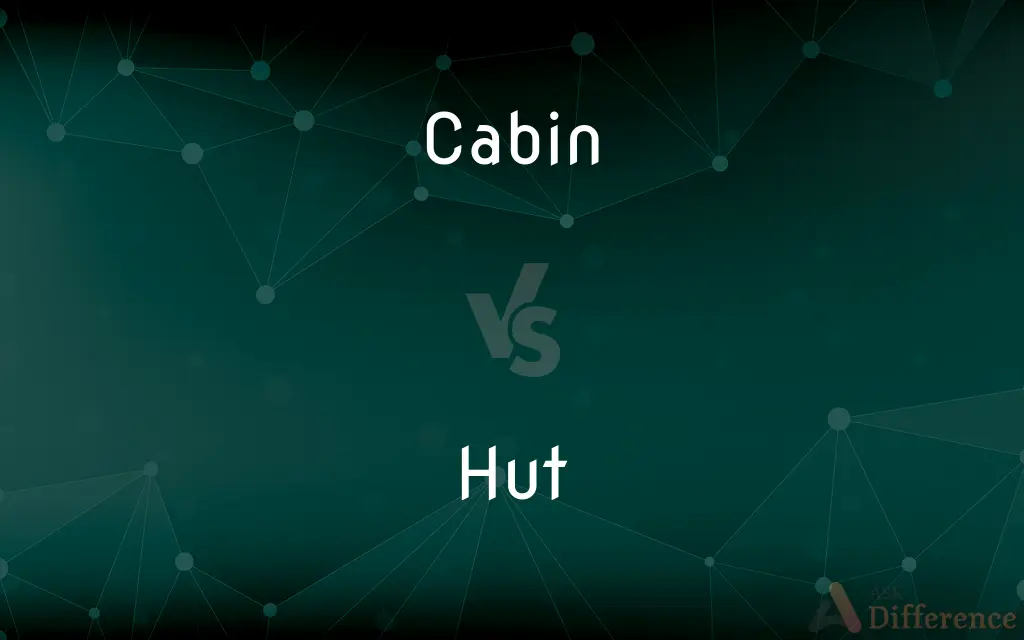Cabin vs. Hut — What's the Difference?
By Tayyaba Rehman & Maham Liaqat — Updated on March 21, 2024
A cabin is a small, rustic dwelling often made of wood, located in rural or wilderness areas, while a hut is a simple, often temporary shelter with basic construction.

Difference Between Cabin and Hut
Table of Contents
ADVERTISEMENT
Key Differences
A cabin, typically constructed of wood and found in rural or wilderness settings, serves as a cozy retreat or living space, often associated with leisure and vacation activities. On the other hand, a hut is characterized by its simple, often primitive construction, using materials readily available in the environment, such as grass, bamboo, or mud, and is used for basic shelter or dwelling purposes, especially in rural or undeveloped regions.
Cabins are known for their aesthetic appeal and connection with nature, often designed to blend with their natural surroundings and offer amenities for comfortable living, such as fireplaces and porches. Huts, however, prioritize functionality over comfort, providing minimal shelter and space, typically without modern amenities, and are built to meet the immediate needs of their inhabitants.
While cabins can be permanent or semi-permanent structures used for recreational purposes, holiday homes, or even as primary residences, huts are often associated with temporary usage or as a solution for economical living, especially in cultures and communities with limited resources.
The construction of cabins involves more advanced techniques and materials, leading to structures that can withstand various weather conditions and provide insulation. In contrast, huts are constructed using simpler techniques that can be easily replicated by the inhabitants themselves, often resulting in structures that are less durable and offer limited protection from the elements.
Cabins often play a significant role in leisure and tourism, attracting individuals seeking a break from urban life and a closer connection with nature. Huts, while they may also serve a cultural or touristic interest in some contexts, are more commonly associated with necessity and survival, particularly in environments where other forms of housing are not readily available or affordable.
ADVERTISEMENT
Comparison Chart
Construction
Made of wood, often with advanced techniques.
Constructed with basic materials like grass, bamboo, or mud.
Purpose
Used for leisure, vacation, or primary residence.
Provides basic shelter, often temporary or economical.
Setting
Located in rural or wilderness areas.
Found in rural, undeveloped, or traditional communities.
Comfort
Offers amenities for comfortable living.
Minimal amenities, focusing on basic shelter.
Durability
Designed to withstand various weather conditions.
Simpler construction, less durable.
Compare with Definitions
Cabin
A cabin is a small, wooden dwelling, often situated in natural surroundings, used for leisure or as a residence.
They rented a mountain cabin for their winter holiday.
Hut
A hut is a simple, often primitive shelter made from natural materials, used for basic accommodation.
The shepherd's hut in the meadow provided a basic shelter for nights spent tending to the flock.
Cabin
Often used as vacation homes, cabins provide a cozy getaway from urban life, offering peace and tranquility.
Their family cabin by the lake was a perfect retreat from the city's hustle.
Hut
Huts are typically constructed using locally sourced materials such as mud, bamboo, or leaves, emphasizing simplicity and accessibility.
The village huts were made of bamboo and thatched roofs, blending seamlessly with the surrounding landscape.
Cabin
Cabins are typically built with wood, featuring a rustic design that harmonizes with the natural environment.
The cabin's log construction and stone fireplace added to its rustic charm.
Hut
Huts serve as a fundamental form of housing in many parts of the world, often reflecting economic and environmental conditions.
In the remote village, families lived in huts that they rebuilt each year after the rainy season.
Cabin
Many cabins come equipped with modern amenities, making them comfortable for extended stays.
Despite its remote location, the cabin had all the modern comforts, including Wi-Fi and a hot tub.
Hut
In many cultures, huts are a traditional form of dwelling, embodying local customs and building techniques.
The traditional huts in the region were constructed using age-old techniques passed down through generations.
Cabin
In some regions, cabins are part of the cultural heritage, reflecting traditional building styles and ways of life.
The historic cabins in the national park showcased the early settlers' architectural ingenuity.
Hut
Basic and utilitarian, huts often lack modern conveniences, focusing instead on providing rudimentary shelter.
The fishing hut on the island had no electricity but offered a place to sleep and store gear.
Cabin
A private room or compartment on a ship
She lay in her cabin on a steamer
Hut
A hut is a primitive dwelling, which may be constructed of various local materials. Huts are a type of vernacular architecture because they are built of readily available materials such as wood, snow, ice, stone, grass, palm leaves, branches, hides, fabric, or mud using techniques passed down through the generations.
Cabin
A small wooden shelter or house in a wild or remote area
The cabin lay three miles into the reserve
Hut
A small, simple, single-storey house or shelter
A beach hut
Cabin
A cubicle or individual work space within a larger office.
Hut
Provide with huts
It will be advisable to hut the troops, for their protection during the cold season
Cabin
Confine within narrow bounds
Once loosed, the idea of equality is not easily cabined
Hut
A crude or makeshift dwelling or shelter; a shack.
Cabin
A small, roughly built house or shelter.
Hut
A temporary structure for sheltering troops.
Cabin
A room in a ship used as living quarters by an officer or passenger.
Hut
A sturdy building offering shelter in the backcountry, as to mountaineers.
Cabin
An enclosed compartment in a boat that serves as a shelter or as living quarters.
Hut
To shelter or take shelter in a hut.
Cabin
The enclosed space in an aircraft or spacecraft for the crew, passengers, or cargo.
Hut
A small, simple one-storey dwelling or shelter, often with just one room, and generally built of readily available local materials.
A thatched hut; a mud hut; a shepherd’s hut
Cabin
To confine or live in or as if in a small space or area.
Hut
A small wooden shed.
A groundsman’s hut
Cabin
(US) A small dwelling characteristic of the frontier, especially when built from logs with simple tools and not constructed by professional builders, but by those who meant to live in it.
Abraham Lincoln was born in a log cabin.
Hut
A small stack of grain.
Cabin
(informal) A chalet or lodge, especially one that can hold large groups of people.
Hut
To provide (someone) with shelter in a hut.
To hut troops in winter quarters
Cabin
A private room on a ship.
The captain's cabin:
Passengers shall remain in their cabins.
Hut
To take shelter in a hut.
Cabin
The interior of a boat, enclosed to create a small room, particularly for sleeping.
Hut
To stack (sheaves of grain).
Cabin
The passenger area of an airplane.
Hut
(American football) Called by the quarterback to prepare the team for a play.
Cabin
The section of a passenger plane having the same class of service.
Hut
Temporary military shelter
Cabin
A signal box.
Hut
Small crude shelter used as a dwelling
Cabin
A small room; an enclosed place.
Cabin
(Indian English) A private office; particularly of a doctor, businessman, lawyer, or other professional.
Cabin
(transitive) To place in a cabin or other small space.
Cabin
(by extension) To limit the scope of.
Cabin
To live in, or as if in, a cabin; to lodge.
Cabin
A cottage or small house; a hut.
A hunting cabin in the west.
Cabin
A small room; an inclosed place.
So long in secret cabin there he heldHer captive.
Cabin
A room in ship for officers or passengers.
Cabin
To live in, or as in, a cabin; to lodge.
I'll make you . . . cabin in a cave.
Cabin
To confine in, or as in, a cabin.
I am cabined, cribbed, confined, bound inTo saucy doubts and fears.
Cabin
Small room on a ship or boat where people sleep
Cabin
A small house built of wood; usually in a wooded area
Cabin
The enclosed compartment of an aircraft or spacecraft where passengers are carried
Cabin
Confine to a small space, such as a cabin
Common Curiosities
How are huts typically constructed?
Huts are typically constructed using simple, natural materials available in the local environment, such as mud, bamboo, or leaves.
What materials are commonly used in cabin construction?
Common materials used in cabin construction include wood (such as logs or timber), stone for foundations or fireplaces, and glass for windows.
Can cabins be used as permanent homes?
Yes, cabins can be used as permanent homes, especially when they are equipped with necessary amenities and built to withstand local weather conditions.
Why are huts considered temporary or economical housing?
Huts are considered temporary or economical housing due to their simple construction, use of readily available materials, and minimal amenities, catering to immediate shelter needs.
Can cabins be found in urban areas?
While cabins are typically associated with rural or wilderness settings, some urban areas might have cabin-style homes or retreats within city limits or nearby natural parks.
Are huts unique to specific cultures or regions?
Yes, huts can be unique to specific cultures or regions, reflecting local building techniques, materials, and traditional designs.
What is the significance of huts in traditional societies?
In traditional societies, huts hold significant cultural and practical value, representing traditional building methods, communal living, and a harmonious relationship with the natural environment.
What amenities might a modern cabin include?
A modern cabin might include amenities such as electricity, plumbing, heating, kitchen facilities, and internet access.
What is the primary purpose of a cabin?
The primary purpose of a cabin is to provide a cozy and comfortable shelter, often for leisure or vacation purposes, in natural settings.
How do environmental conditions influence hut construction?
Environmental conditions influence hut construction through the choice of materials and design, ensuring the structure is suited to local weather, available resources, and cultural practices.
Are there modern interpretations of huts?
Yes, modern interpretations of huts incorporate sustainable materials and eco-friendly designs, blending traditional simplicity with contemporary environmental consciousness.
How do cabins contribute to tourism?
Cabins contribute to tourism by providing unique and immersive lodging options for travelers seeking natural beauty, solitude, and outdoor activities.
Share Your Discovery

Previous Comparison
Apex vs. Nadir
Next Comparison
Possible vs. PossiblyAuthor Spotlight
Written by
Tayyaba RehmanTayyaba Rehman is a distinguished writer, currently serving as a primary contributor to askdifference.com. As a researcher in semantics and etymology, Tayyaba's passion for the complexity of languages and their distinctions has found a perfect home on the platform. Tayyaba delves into the intricacies of language, distinguishing between commonly confused words and phrases, thereby providing clarity for readers worldwide.
Co-written by
Maham Liaqat














































